Seyed Mehdi Moazen Jamshidi1* , Seyed Mansoor Moazen Jamshidi2 and Mohammad Ali Rostaii Mehr3
1Master of Physiology, Guilan University-Agricultural Department-Animal Science Guilan, Iran. 2Department of Orthopedic Surgery, Mousavi Hospital, Zanjan University of Medical Sciences, Zanjan, Iran. 3Associated Professor of Physiology in Guilan University, Agricultural Department, Guilan, Iran.
DOI : https://dx.doi.org/10.13005/bpj/511
Abstract
Increasing resistance against conventional anticoccidial drugs and consequence of their residues has paid the attention toward more effective and safe compounds. Artemisia plant and the apacox complex are potential candidates that their anticoccidial effects has been previously discusse: This study aimed to determin an appropriate dosage from the extract of Artemisia siberi and evaluate its anticcocidial effects compared to apacox complex and lasalosid drug. Artemisinin extract was extracted from Artemisia siberi by petroleum ether the apacox complex and lasalosid bought from the pharmacy by our order.105 chicks were divided in to 7 group tree replicates each (n=15).artemisia extract in two dosages 0/5 and 1/5 mg/kg for group A &B and the apacox complex in two dosages 0/5 and 1/5 gr/kg for group C&D and lasalosid in 75 mg/kg were used for the E group of broilers from the first day as feed additive . infected group(F) and non infected group(G) didn’t recive any medication . Experimental coccidiosis was induced in chicks by oral administration of 100000 oocysts/chick on 14th day . fecal samples of each group were collected for 5 days from 15th day until 19th day and the OPG (oocyst per gram) was determined as anticoccidial index. Artemisia and apacox complex significantly decreased OPG value in treated group although it was lower than lasalosid group .artemisia extract in 1/5 mg /kg had stronger power than apacox in its two dosage and Artemisia in 0/5 mg/kg .this means Artemisia have dependent dosage effect in dosage lower than 1/5 mg/kg. This study showed that the Artemisia siberi extract can be considered as a new effective and safe anticoccidial drug although it is weaker than lasalosid
Keywords
Coccidiosis; Artemisia ciberi; Lasalosid; Apacox complex
Download this article as:| Copy the following to cite this article: Jamshidi S. M. M, Jamshidi S. M. M, Mehr M. A. R. Comparsion Between Anti Coccidial Effectes of Artemisia Siberi Extract and Apacox Copmplex and Lasalosid in Experimental Infected Broilers with Coccidiosis. Biomed Pharmacol J 2014;7(2) |
| Copy the following to cite this URL: Jamshidi S. M. M, Jamshidi S. M. M, Mehr M. A. R. Comparsion Between Anti Coccidial Effectes of Artemisia Siberi Extract and Apacox Copmplex and Lasalosid in Experimental Infected Broilers with Coccidiosis. Biomed Pharmacol J 2014;7(2). Available from: http://biomedpharmajournal.org/?p=3048 |
Introduction
Coccidiosis is the most is the common parasitic disease of poultry that its economic damage is considerable due to its global dissemination and almost constant presence in poultry farms. It must be understood that economic damage of the disease is not only mortality caused by it, but also it is in fact the most important factor in growth reduction, body weight reduction and Increased feed conversion ratio (1,2,3,5,6). In a simple calculation, economic losses over 1 billion dollars and mortality of approximately 6-7 % are of the complications of this disease in the United States of America. Although useful drugs against coccidiosis has been marketed since 1940 (7,11,12,13,22,23), the incidence of drug resistance and the presence of drug residues in chicken meats have drawn attentions to the use of safe practices (4,8,20,21). In the second step, vaccines are not also accepted due to the high cost and not covering all pathogenic species. One of the ways that has been very much accepted nowadays is to use herbal compounds and their active ingredients to treat the disease. Because, on the one hand, these compounds are very cheap and available and on the other hand, no resistance to molecules contained within them will not happen. In this paper, we investigate the effect of two herbal compounds, Artemisia Siberi and the herbal complex of Apaco, against coccidiosis and then compare the two with each other and with a known drug compound, called lasalosid (9, 10, and 13).
Artemisia Siberi is a plant used in traditional Chinese medicine as an anti-malarial treatment for many years, particularly for drug resistant malaria and cerebral malaria. Arab in 2006 demonstrated that active ingredient in native species of Artemisia Siberi in Iran contains Artemisinin active ingredient and then measured and showed its effects. In later years, the anti-coccidial effects of Artemisinin active ingredient against coccidial was shown and even in 2008, the dose of 2.5 of Artemisia Siberi extract was introduced very impressive against coccidiosis (15,16).
Herbal Complex of apacox is an herbal compound containing extracts from 4 following plants that is available under the brand name of Apacox as liguid. Plants used in the complex include:
1- Agrimoria – eupotoria
2- Echinacea – angustifolia
3- Ribes – nigrum
4- Cinchona – Succirubra
Anti-coccidianl effects of this herbal complex have been demonstrated in various articles (31 , 32 , 33, 34, 35). This paper specifies the effect of these two groups of herbal medicines and lasalosid drug with each other by examining the number of oocysts excreted from per gram of feces.
Materials and Methods
Animals and their maintenance
105 1-day-old Ross broiler chickens were prepared and in the same day, they were divided into seven 15-membered groups and each group, three 5-membered repeats. Chickens’ location was perfectly clean and free from any infection. Artificial light was available in a total of 24 hours. Ventilation was maintained on an ongoing basis. Temperature was about 32 °C during the first week and reduced about 3 °C every week until the end of the course (17,18, 19).
Diet
Water was completely available and diet was also completely available based on AOAC protocol (24,14).
Preparation of Artemisia Siberi extract
To prepare the Artemisia Siberi extract, at first aerial parts of the plant were collected and ground after drying at 28°C and the obtained powder was maintained at room temperature for next steps. Petroleum ether solution was used to extract the powder. First, 2.5 g Artemisia Siberi powder was solved in 200ml petroleum – ether and then heated for 6 hours at 30-50°C in Soxhlet device. The resulting extract was then passed through a filter paper and converted into a dried powder by evaporation device. The dried powder is an extract of Artemisia Siberi and contains Artemisinin active ingredient that has a low solubility in water and alcohol, but it is suspended in distilled water and given to the chickens of groups A and B with a dose of 0.5 and 1.5 from the first day (25).
Preparation of apacox herbal complex extract: the mentioned herbal complex, which is made in liquid form and at a concentration of 100 mg/kq, is prepared and given to the chickens of groups C and D with a dose of 0.5 and 1.5 from the first day.
Preparation of Lasalosid drugs: Lasalosid drug is also prepared and given to the chickens of group E with an effective dose of from the first. Group F is patients without treatment and group G is the control.
How and when chickens are infected: Of 7 chicken sprepared, 6 groups should be experimentally infected with coccidiosis. For this purpose, a suspension containing E.Tenellaoocysts fully sporulated in 5% potassium dichromate solution at 3-5 °C with sufficient Pathogenicity became available a 100.000 oosyts permlsuspension. 6groups of chickens were infected from 14th day through giving 1ml suspension containing E.Tenella oocysts by gavage. The control group was treated with 1cc distilled water.
Evaluation of parameters: after infection of 14th day, the treatment continued
and then from the 20th to 24th day, the feces of each group was collected over 24 hours and studied to determine the number of oocysts per gram of feces excreted by McMaster method (26,27,28,29,30).
Data Analysis
The study was conducted in a completely randomized form with 7 groups, and each with three 5-membered repeats. 2 patient groups of A and B with Artemisia Siberi from the first day, 2 patient groups of C and D with apocox from the first day, patient group of E with lasalosid drug from first day, and finally patient group of F and healthy group of E were examined in terms of mean oocyst shedding in each group in 20-24th day with significance of p<0.05.
Results
After the survey conducted, the results are as follows. Artemisia Siberi extract, Apacox herbal complex and Lasalosid Drug obviously significantly reduce the number of oocysts per gram of feces. The effect of Artemisia Siberi extract at a dose of 0.5 mg/kq and comparing with the positive control group F is obvious in Fig. 1 that shows significant reducing effects. The effect of Artemisia Siberi extract at a dose of 1.5 mg/kq and comparing with the positive control group F is obvious in Fig. 2 that also illustrates significant reducing effects. The effects of herbal complex extract at a dose of 0.5 mg/kq in Fig. 3 and a dose of 1.5 mg/kq in Fig. 4 compared with the positive control group F represents a reducing effect on oocyst shedding them. Nearly 100% reducing effect of lasalosid drug and comparing with the positive control group F is shown in Fig. 5. Finally, the effect of each five challenges are compared with each other in terms of the mean number of oocyst excreted within 5 days in Fig 6.
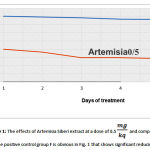 |
Figure 1: The effects of Artemisia Siberi extract at a dose of 0.5 mg/kq and comparing with the positive control group F is obvious in Fig. 1 that shows significant reducing effects.
|
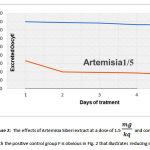 |
Figure 2: The effects of Artemisia Siberi extract at a dose of 1.5 mg/kq and comparing with the positive control group F is obvious in Fig. 2 that illustrates reducing effects.
|
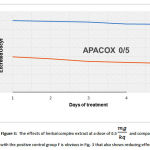 |
Figure 3: The effects of herbal complex extract at a dose of 0.5 mg/kq and comparing with the positive control group F is obvious in Fig. 3 that also shows reducing effects.
|
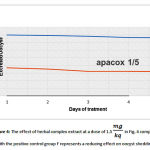 |
Figure 4: The effect of herbal complex extract at a dose of 1.5 mg/kq in Fig. 4 compared with the positive control group F represents a reducing effect on oocyst shedding.
|
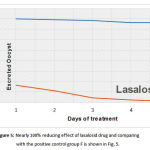 |
Figure 5: Nearly 100% reducing effect of lasalosid drug and comparing with thepositive control groupFis shown in Fig. 5.
|
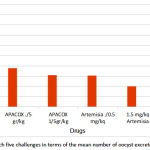 |
Figure 6: The effects of each five challenges in terms of the mean number of oocyst excreted within 5 days in Fig 6.
|
There is a significant difference in OPG between positive control group F and each treated patient group, indicating the positive and useful effects in all remedies against coccidiosis (the number of oocyst per gram of feces excreted = OPG)
There is a significant difference in OPG between the group treated by Artemisia extract at a dose of 1.5 mg/kg and the group treated by Artemisia extract at a dose of 0.5 mg/kg and the group treated by apacox herbal complex at both doses, in terms of reduction of oocyst shedding.
There is no significant difference in OPG between the group treated by Artemisia extract at a dose of 0.5 mg/kg and two patient groups treated by different concentrations of apacox, indicating the same effect of 0.5 mg/kg Artemisia with both doses of 0.5 and 1.5 mg/kg apacox, that it also suggests that the effect of Artemisia extract is more useful and more effective than apacox.
There is no significant difference in OPG between two different concentrations of apacox.
In total, there is a significant difference in OPG between the group treated by lasalosid drug and four groups treated by herbal extract, that it also suggests that the effect of lasalosid drug is better than other herbal compounds. Totally, the current paper indicates that Artemisia Siberi and apacox herbal complex, each one has a significant effect on the reduction of oocyst shedding in infected chickens. The effect of Artemisia extract at a dose of 1.5 mg/kg is much more than apacox complex and Artemisia extract at a dose of 0.5 mg/kg and it can imply that we can profit from this extract at this dose as an effective treatment against coccidiosis. Of course, Artemisia extract at a dose of 2.5 mg/kg had been recognized useful in previous articles (25).
In our paper, there was a significant difference between the effect of Artemisia extract at doses of 1.5 mg/kg and 0.5 mg/kg. It can support the positive effects depending on the dose of Artemisia extract at doses below 2.5 mg/kg and it is exactly in opposition to papers which negate dose-dependent effects at doses higher than 2.5 mg/kg, meaning that totally, Artemisia Siberi extract can be applied up to a maximum dose of 2.5 mg/kq as dose-dependent manner.
Discussion
The cause of anti-coccidiosis beneficial effects of this extract is attributed to Artemisinin active ingredient which is a Sesquiterpene – Lactone – Trioxane that has widespread medicinal effects such as antimalarial and anticoccidial. Of course, the effect of Artemisia Siberi extract at doses of 1 and 2.5 mg/kg obviously reduced oocyst shedding in many other articles. This study not only emphasizes on earlier studies and provides a relative effective dose of the extract to treat coccidiosis, but also on the other hand, is the only study that compares the effect of Artemisia extract with apacox complex and Lasalosid drug and provides a useful comparison. Of course, the only problem of Artemisia extract is its low solubility in water, that like the paper by Mr. Arab, it can be granulated as standard and marketed. It is obvious that, more research is certainly needed to explore the effects and side effects of long-term treatment with Artemisia Siberi extract in days of treatment for broiler chickens. Totally, after the present study, if we can be aware of the side effects of the extract and also, standardize Artemisinin active ingredient, that exists in the extract and in case of using different parts of a plant or plants, its amount varies in powdered extract, Artemisia Siberi extract can be benefited as a useful anticoccidial treatment.
Conclusion: In total, anticoccidial effect of Artemisia Siberi extract at a dose of 1.5 mg/kg is much better than apacox herbal complex at its therapeutic doses. Although this effect is not similar to that of lasalosid drug, it can be successfully used as an anticoccidial treatment due to successfully reducing an enough percentage of oocyst shedding in chickens that is much better than apacox herbal complex which is recently commercialized and widely used, especially in Europe and America.
Acknowledgments
In the end, we would like to thank Zanjan University of Medical Sciences for assisting in provision of equipment and facilities, and especially Dr. Shirazi.
References
- Abbas R, Iqbal Z, Khan A, Sindhu ZI, Alikhan JU, Raza A(2011). Options for Integrated Strategies for the Control of Avian Coccidiosis, Int. J. Agric& Biol,Vol. 14, No. 6.
- Arshad M, Neubauer C, Hasnain S, Hess M(2012). Peganum harmala Can Minimize Escherichia coli Infection in Poultry, but Long-Term Feeding May Induce Side Effects, Poultry Science,vol. 87,240–249.
- Arab H, Kabotari J, Rahbari S, Nabian S, Soltanmohamadi A, Piralikheirabadi KH(2012). Comparison between anticoccidial effect of granulated Artemisia siberi extract and pure Artemisinin in affected broilers, J. Vet. Res,,vol.67, No.2,119-125.
- Asghari GH, Ghannadi A, Hemmatian S(2006). The production of beta carbolin alkaloid in cellular suspension mixed of peganum harmala and varthemica persica,Hormozgan university of medical science journal,vol.10,No.2,137-143.
- Aarons DH, Rossi GV, Orzechowski RF(1977).Cardiovascular actions of three harmala alkaloids: harmine, harmaline, and harmalol. J Pharmaceut Sciences,, vol.66, 1244-1248.
- Adibneishabori M, Razmi GH, Keleidari GH(2003).A study of coccidiosis in the pullets of laying hens in mashhad area,Pajouhesh&sazandegi,No.71,31-35.
- Brati M, Sharifi A, Sharififar F(2009). In vitro Evaluation of Anti-Leishmanial Activities of Zataria Multiflora Boiss, Peganum Harmala and Myrtus Communis by Colorimetric Assay, Kerman university of medical science journal, vol.17,No.1,32-41.
- Bozorgmehrifar A, Khaki Z, Modirsaneii M, Shojadost B, Mehdikiaii M(2009). Effects Of The Administration Of Anticoccidial Vaccines And Drugs On Intestinal Lesions And Biochemical Vari Ables Of Broiler Chicks Challenged With Experimental Coccidiosis, J. Vet. Res,vol. 64, No.3,185-191.
- Damron,B.L, R. H(1999). Harms.The effect of dietary lasalocid or monensin in the presence of roxarsone and graded methionine levels on broiler performance and processing characteristics,poult.sci,vol.56,1487-1497
- Diba K, Geramishomar M, Sharbatkhori M, Hosinpour L(2009). Peganum harmala extract inhibitory effect on candidia and aspergillus species ,Uromieih university of medical science,vol.20,No.4,271-277.
- Darabi N, Felahati M, Mahmodian M(2007). Evaluation of toxicity substances (extract oihyndropyridine derivative ,saff flower andpeganum harmala)by saccharomyces cerevisiae,Jums journal,vol.5,No.1,1111-1114.(in farsi
- Jolley,W.R., Bardsley, K.D(2011). Ruminant coccidiosis , Vet Clin Food Anim Pract,vol. 22,No.3,613-617
- Hoseini SE, Sadegi HE, Daneshi A(2009). Peganum harmala extract effect on mice thyroid function,Armaghane danesh journal,vol.14(56),No.4.
- Hilbrich, p(1985).Disinfection experiments on eimeria tenellae oocytes ,Berlinger und munchener Tierarztliche,vol.88,141-148.
- Hashemi A, Shams S, Samedani A(2011). Antibacterial effects of methanolic extracts of Zataria multiflora,Myrtus communis and Peganum harmala on Pseudomonas aeruginosa producing ESBL, Arak Medical University Journal (AMUJ), vol.14(57),No.4,105-113.
- Hashemi A, Naebi A, Sadegi M, Faramarzi A, Delazar A, Rezazadeh H(2009) . Study of the methanolic extract of Peganum seeds on convulsion induced by Strychnine in Swiss mice,Pharmaceutical Sciences, Vol.15, No.3, 257- 262.
- Hoseini SE, Sadegi HE, Daneshi A(2009). Peganum harmala extract effect on mice thyroid function,Armaghane danesh journal,vol.14(56),No.4.
- Farouk L, Laroubi A, Aboufatima R, Benharef A,Chait A(2009). Antinociceptive Activity of Various Extracts of Peganum harmala L. and Possible Mechanism of Action, IJPT ,vol.8,29-35.
- Fathiazad F, Azarmi Y, Khodaie L(2006). Pharmacological Effects of Peganum harmala Seeds Extract on Isolated Rat Uterus, Iranian Journal of Pharmaceutical Sciences,Spring ,vol.2,No.2, 81-86.
- Falahati M, Fatehi R, kiani J.(2009). Anti fungal effect of peganum harmala extract, qom university of medical science journal ,Vol.5, No.3 , 14-17.
- Kiani S, Sajjadi N, Ataei A(2008). Peganum harmala seed extract can prevent HSV-1 replication in vitro, Iranian Journal of Virology ,vol.2,No.4.
- Mazandarani M, Sinesepehr K, Baradaran B, Khouri V(2012). Autecology, Phytochemical and Antioxidant Activity of Peganum harmala L. Seed Extract in North of Iran (Tash Mountains), Journal of Medicinal Plants and By-products ,vol .2, 151-156.
- Mahmoudian M, Jalilpour H(2002), Salehian P.Toxicity of Peganum harmala: Review and a Case Report, IJPT ,Autumn , vol. 1 ,no. 1.
- Masood JA, Mahdavi MI(2000) . study of scolecide effect of peganum harmala extracts on hidatid cyst protoscolex,Tehran university of medical science journal,vol.60,No.3,215-226.
- Mashregi M, Niknia S(2012).The Effect of Peganum harmala and Teucrium polium Alcoholic Extracts on Growth of Escherichia coli O157, Jundishapur J Microbiol, vol.5,No.
- Rahimi P, Ebrahimi S, Ourmazdi H, Seseleh M, Karjalian M, Hajhasani G (2011). In vitro and in vivo activities of Peganum harmala extract against Leishmania major, J Res Med Sci ,vol. 16,No.8, 1032-1039.
- Rahimi SH, Dashkibron M, Mehdikiaii SM(2003). The effect of betain on oocyst sheding in coccidiosis and performance of broiler, Tehran university of vertinary science journal,vol.58,No.1,123-129.
- Rajab A, Bozorgmehrifar M, Modirsaneii M, Shoiajdost B, Mehdikiaii SM, Rahbari S(2003). Effect of administration of anti-coccidial drugs and vaccines on broiler chicks performance in experimental coccidiosis,Tehran university of vertinary science journal,vol.59,No.1.
- Ralph B, Dell, Steve Holleran, and Rajasekhar Ramakrishnan(2002), Sample size determination, larJournal ; vol.43,No.4,207-213
- Raman M, Banu S, Gomathinayagam S, Raj K(2011). Lesion scoring technique for assessing the virulence and pathogenicity of Indian field isolates of avian Eimeria species, veterinarski archive,vol.81,No.2.
- Shijadost B, Modirsanneii M, Rahbari S, Mansoori B(2009). Effect Of Concomitant Use Of Probiotic And Coccidiosis Vaccine In Experimental Coccidial Infection Of Broiler Chickens,J.Vet.Res, vol.64,No.1,33-40.
- Tafti, A.K and Mansourian, M(2008). Pathologic lesions of naturally occurring coccidiosis in sheep and goats. Comp Clin Pathol,vol. 17,87–91.
- Zkhtar M, Hafeez M, Haq A(2005).Immunity in poultry –A review,international journal of pourtly science,,vol.4,No.10,812-817.
- Zaker F, Oodi A, Mahmodian shoshtari M, Soleimani M(2003). Peganum harmala extract effects on cellular derivated of acute promyelocytic leukaemia,Zanjan university of medical science journal,vol.45,37-48.
- Zaman M, Iqbal Z, Abbas RA, N.khan M(2012).Anticoccidial activity of herbal complex in broiler chickens challenged with Eimeria tenella, Parasitology Cambridge university journal , vol.139, 237–243.








